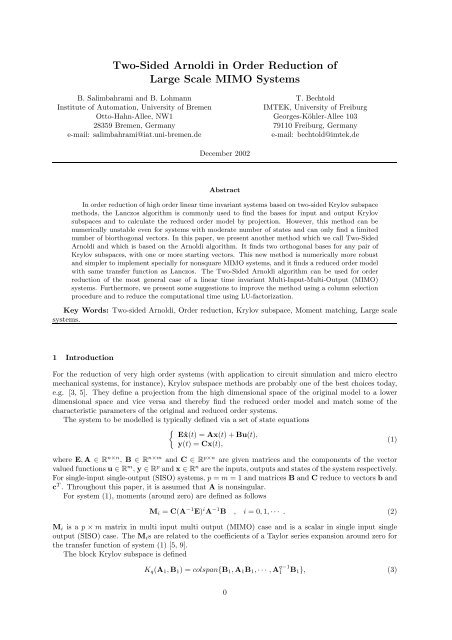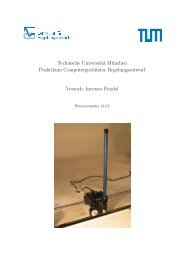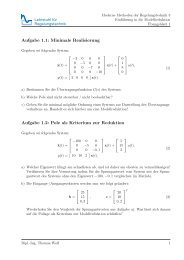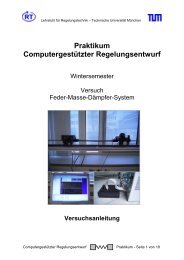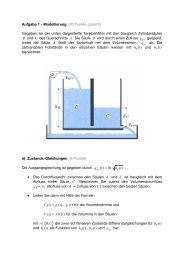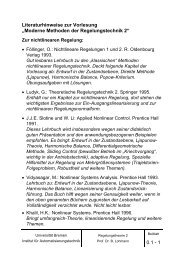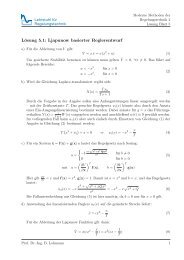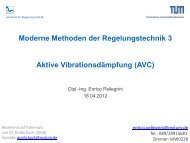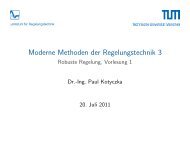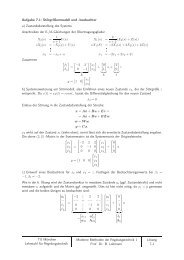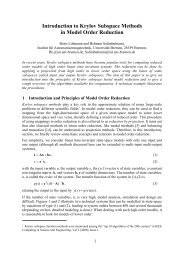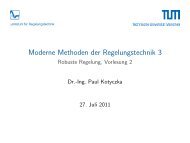Two-Sided Arnoldi in Order Reduction of Large Scale MIMO Systems
Two-Sided Arnoldi in Order Reduction of Large Scale MIMO Systems
Two-Sided Arnoldi in Order Reduction of Large Scale MIMO Systems
Create successful ePaper yourself
Turn your PDF publications into a flip-book with our unique Google optimized e-Paper software.
<strong>Two</strong>-<strong>Sided</strong> <strong>Arnoldi</strong> <strong>in</strong> <strong>Order</strong> <strong>Reduction</strong> <strong>of</strong><br />
<strong>Large</strong> <strong>Scale</strong> <strong>MIMO</strong> <strong>Systems</strong><br />
B. Salimbahrami and B. Lohmann<br />
Institute <strong>of</strong> Automation, University <strong>of</strong> Bremen<br />
Otto-Hahn-Allee, NW1<br />
28359 Bremen, Germany<br />
e-mail: salimbahrami@iat.uni-bremen.de<br />
T. Bechtold<br />
IMTEK, University <strong>of</strong> Freiburg<br />
Georges-Köhler-Allee 103<br />
79110 Freiburg, Germany<br />
e-mail: bechtold@imtek.de<br />
December 2002<br />
Abstract<br />
In order reduction <strong>of</strong> high order l<strong>in</strong>ear time <strong>in</strong>variant systems based on two-sided Krylov subspace<br />
methods, the Lanczos algorithm is commonly used to f<strong>in</strong>d the bases for <strong>in</strong>put and output Krylov<br />
subspaces and to calculate the reduced order model by projection. However, this method can be<br />
numerically unstable even for systems with moderate number <strong>of</strong> states and can only f<strong>in</strong>d a limited<br />
number <strong>of</strong> biorthogonal vectors. In this paper, we present another method which we call <strong>Two</strong>-<strong>Sided</strong><br />
<strong>Arnoldi</strong> and which is based on the <strong>Arnoldi</strong> algorithm. It f<strong>in</strong>ds two orthogonal bases for any pair <strong>of</strong><br />
Krylov subspaces, with one or more start<strong>in</strong>g vectors. This new method is numerically more robust<br />
and simpler to implement specially for nonsquare <strong>MIMO</strong> systems, and it f<strong>in</strong>ds a reduced order model<br />
with same transfer function as Lanczos. The <strong>Two</strong>-<strong>Sided</strong> <strong>Arnoldi</strong> algorithm can be used for order<br />
reduction <strong>of</strong> the most general case <strong>of</strong> a l<strong>in</strong>ear time <strong>in</strong>variant Multi-Input-Multi-Output (<strong>MIMO</strong>)<br />
systems. Furthermore, we present some suggestions to improve the method us<strong>in</strong>g a column selection<br />
procedure and to reduce the computational time us<strong>in</strong>g LU-factorization.<br />
Key Words: <strong>Two</strong>-sided <strong>Arnoldi</strong>, <strong>Order</strong> reduction, Krylov subspace, Moment match<strong>in</strong>g, <strong>Large</strong> scale<br />
systems.<br />
1 Introduction<br />
For the reduction <strong>of</strong> very high order systems (with application to circuit simulation and micro electro<br />
mechanical systems, for <strong>in</strong>stance), Krylov subspace methods are probably one <strong>of</strong> the best choices today,<br />
e.g. [3, 5]. They def<strong>in</strong>e a projection from the high dimensional space <strong>of</strong> the orig<strong>in</strong>al model to a lower<br />
dimensional space and vice versa and thereby f<strong>in</strong>d the reduced order model and match some <strong>of</strong> the<br />
characteristic parameters <strong>of</strong> the orig<strong>in</strong>al and reduced order systems.<br />
The system to be modelled is typically def<strong>in</strong>ed via a set <strong>of</strong> state equations<br />
{<br />
Eẋ(t) =Ax(t)+Bu(t),<br />
(1)<br />
y(t) =Cx(t),<br />
where E, A ∈ R n×n , B ∈ R n×m and C ∈ R p×n are given matrices and the components <strong>of</strong> the vector<br />
valued functions u ∈ R m , y ∈ R p and x ∈ R n are the <strong>in</strong>puts, outputs and states <strong>of</strong> the system respectively.<br />
For s<strong>in</strong>gle-<strong>in</strong>put s<strong>in</strong>gle-output (SISO) systems, p = m = 1 and matrices B and C reduce to vectors b and<br />
c T . Throughout this paper, it is assumed that A is nons<strong>in</strong>gular.<br />
For system (1), moments (around zero) are def<strong>in</strong>ed as follows<br />
M i = C(A −1 E) i A −1 B , i =0, 1, ··· . (2)<br />
M i is a p × m matrix <strong>in</strong> multi <strong>in</strong>put multi output (<strong>MIMO</strong>) case and is a scalar <strong>in</strong> s<strong>in</strong>gle <strong>in</strong>put s<strong>in</strong>gle<br />
output (SISO) case. The M i s are related to the coefficients <strong>of</strong> a Taylor series expansion around zero for<br />
the transfer function <strong>of</strong> system (1) [5, 9].<br />
The block Krylov subspace is def<strong>in</strong>ed<br />
K q (A 1 , B 1 )=colspan{B 1 , A 1 B 1 , ··· , A q−1<br />
1 B 1 }, (3)<br />
0
where A 1 ∈ R n×n and B 1 ∈ R n×m , and start<strong>in</strong>g vectors are located <strong>in</strong> the columns <strong>of</strong> the matrix B 1 .<br />
The vectors which span the subspace are called the basic vectors.<br />
Consider<strong>in</strong>g the state space representation (1), two Krylov subspaces K q1 (A −1 E, A −1 B) and<br />
K q2 (A −T E T , A −T C T ) both with the same rank are used for model order reduction and are called <strong>in</strong>put<br />
and output Krylov subspaces respectively.<br />
In the next section, we will first recall order reduction by projection. In so-called one-sided methods,<br />
the most commonly used algorithm is <strong>Arnoldi</strong>, as <strong>in</strong>troduced <strong>in</strong> section 3. Section 4 then presents the<br />
new two-sided <strong>Arnoldi</strong> approach, followed by some improtant implementation aspects <strong>in</strong> sections 5 to<br />
7. <strong>Two</strong> application examples prove the ease <strong>of</strong> use and the numerical robustness <strong>of</strong> the method, and we<br />
conclude by a short comparison <strong>of</strong> one-sided <strong>Arnoldi</strong>, Lanczos, and two-sided <strong>Arnoldi</strong>.<br />
2 <strong>Order</strong> reduction us<strong>in</strong>g Krylov subspace method<br />
Consider a projection as follows:<br />
x = Vx r ,<br />
V ∈ R n×q , x ∈ R n , x r ∈ R q ,<br />
(4)<br />
where q
Algorithm 1 <strong>Arnoldi</strong> algorithm with deflation us<strong>in</strong>g modified Gram-Schmidt [6]:<br />
0. Start: Delete all l<strong>in</strong>early dependent start<strong>in</strong>g vectors to f<strong>in</strong>d m 1 <strong>in</strong>dependent start<strong>in</strong>g vectors for the<br />
given Krylov subspaces then set<br />
v 1 = b 1<br />
√ .<br />
b<br />
T<br />
1 b 1<br />
where b 1 is the first start<strong>in</strong>g vector after delet<strong>in</strong>g the dependent start<strong>in</strong>g vectors.<br />
1. For i =2, 3, ··· , do,<br />
(a) Calculat<strong>in</strong>g the next vector: If i ≤ m 1 the next vector is the i-th start<strong>in</strong>g vector. Otherwise,<br />
the next vector is<br />
r i = A 1 v i−m1 .<br />
(b) Orthogonalization: Set ˆv i = r i then for j=1 to i-1 do:<br />
h = ˆv i T v j (8)<br />
ˆv i = ˆv i − hv j .<br />
(c) Normalization: If vector ˆv i is zero, reduce m 1 to m 1 − 1 and if m 1 isnonzerogotostep1.a<br />
and if m 1 is zero break the loop. Otherwise, if ˆv i ≠0the i-th column <strong>of</strong> matrix V is<br />
v i =<br />
ˆv i<br />
√ˆv<br />
T<br />
i ˆv i<br />
.<br />
(d) Increase i andgotostep1.a.<br />
By know<strong>in</strong>g that at each step <strong>of</strong> the <strong>Arnoldi</strong> algorithm, the i-th column <strong>of</strong> V is a l<strong>in</strong>ear comb<strong>in</strong>ation<br />
<strong>of</strong> the first i basic vectors, it is not difficult to show that the vectors {v 1 , ··· , v i } span the same space as<br />
the first i basic vectors <strong>of</strong> the given Krylov subspace.<br />
One <strong>of</strong> the properties <strong>of</strong> a Krylov subspace is that, if the i-th basic vector related to start<strong>in</strong>g vector b j<br />
is a l<strong>in</strong>ear comb<strong>in</strong>ation <strong>of</strong> all previous basic vectors, then all other basic vectors p i+m1 ,p i+2m1 , ··· related<br />
to start<strong>in</strong>g vector b j are l<strong>in</strong>ear comb<strong>in</strong>ation <strong>of</strong> the first i − 1 basic vectors. In step 1.b <strong>of</strong> algorithm 1, if<br />
ˆv i is zero, it means that the i-th basic vector is a l<strong>in</strong>ear comb<strong>in</strong>ation <strong>of</strong> the previous basic vectors and<br />
all basic vectors p i ,p i+m1 , ··· must be deleted <strong>in</strong> the next iterations. This can be done by go<strong>in</strong>g one<br />
step back and reduc<strong>in</strong>g the parameter m 1 . If ˆv i is nonzero, it means that the first i basic vectors are<br />
l<strong>in</strong>early <strong>in</strong>dependent because, as discussed above, {v 1 , ··· , v i−1 , ˆv i } span the same space as the first i<br />
basic vectors and all <strong>of</strong> them are <strong>in</strong>dependent.<br />
4 <strong>Two</strong>-sided <strong>Arnoldi</strong> algorithm<br />
As mentioned <strong>in</strong> section 2, us<strong>in</strong>g any pair <strong>of</strong> bases <strong>of</strong> <strong>in</strong>put and output Krylov subspaces <strong>in</strong> projection<br />
leads to match some <strong>of</strong> the first moments and f<strong>in</strong>ds a reduced system with the same transfer function. In<br />
most applications, the basic vectors used <strong>in</strong> the def<strong>in</strong>ition <strong>of</strong> Krylov subspaces tend to be almost l<strong>in</strong>early<br />
dependent even for moderate values <strong>of</strong> n. So, they should not be used <strong>in</strong> numerical computations. Instead,<br />
there exist other suitable bases that can be applied <strong>in</strong> order reduction.<br />
One <strong>of</strong> the ideas to avoid the numerical problems is orthogonaliz<strong>in</strong>g the vectors. By us<strong>in</strong>g biorthogonalization,<br />
the Lanczos algorithm [7] generates two sequences <strong>of</strong> basis vectors which span the <strong>in</strong>put<br />
and output Krylov subspaces. Unfortunately, <strong>in</strong> practice this algorithm can only f<strong>in</strong>d a very limited<br />
number <strong>of</strong> biorthogonal basis vectors <strong>in</strong> many applications. In this section we <strong>in</strong>troduce another method<br />
called <strong>Two</strong>-<strong>Sided</strong> <strong>Arnoldi</strong> to f<strong>in</strong>d the bases necessary for projection and f<strong>in</strong>d<strong>in</strong>g the reduced order model.<br />
This new method <strong>in</strong> comparison to Lanczos is numerically more stable and easier to implement for the<br />
general representation <strong>of</strong> the systems specially for the nonsquare (m ≠ p) <strong>MIMO</strong> systems. This method<br />
comprises the follow<strong>in</strong>g steps:<br />
Algorithm 2 <strong>Two</strong>-sided <strong>Arnoldi</strong> algorithm:<br />
0. Choose the appropriate <strong>in</strong>put and output Krylov subspaces.<br />
2
1. Apply <strong>Arnoldi</strong> algorithm 1 to the <strong>in</strong>put Krylov subspace to f<strong>in</strong>d the matrix V.<br />
2. Apply <strong>Arnoldi</strong> algorithm 1 to the output Krylov subspace to f<strong>in</strong>d the matrix W.<br />
3. F<strong>in</strong>d the reduced order model by apply<strong>in</strong>g projection to the orig<strong>in</strong>al system the same as equation 5.<br />
Suppose that for a system with m <strong>in</strong>puts and p outputs, the reduced model with order q is desired.<br />
In this case each moment has m · p entries. Each column <strong>of</strong> matrices V and W leads to match one more<br />
row or column <strong>of</strong> the moment matrices. So, there is no need to <strong>in</strong>crease q such that it is a multiple <strong>of</strong><br />
both, m and p. In two-sided methods m · q + p · q entries <strong>of</strong> the characteristic parameters <strong>of</strong> the orig<strong>in</strong>al<br />
and reduced order models match.<br />
5 Selection procedure<br />
The moments <strong>of</strong> the <strong>MIMO</strong> system (1) are a p × m matrices M i , where each column is related to an<br />
<strong>in</strong>put and each row is related to an output <strong>of</strong> the system. As will be shown <strong>in</strong> this section, it is possible<br />
to match <strong>in</strong>dividual columns (and rows) up to a higher <strong>in</strong>dex i than other columns (and rows). In this<br />
way, for more important entries <strong>of</strong> the moment matrices the number <strong>of</strong> matched parameters is <strong>in</strong>creased<br />
and for less important entries <strong>of</strong> the moment matrices the number <strong>of</strong> matched parameters is decreased,<br />
while the sum <strong>of</strong> the matched parameters is constant. This concept can be more useful when the number<br />
<strong>of</strong> <strong>in</strong>puts and outputs are high.<br />
Consider only an <strong>in</strong>put Krylov subspace. For a system with m <strong>in</strong>puts, there exist m start<strong>in</strong>g vectors<br />
that must be orthogonalized and normalized to each other, and they produce the first m columns <strong>of</strong> matrix<br />
V, v 1 , ··· , v m see figure 1. For the next vector, there are m candidates, A −1 Ev 1 , ··· , A −1 Ev m , called<br />
r 1 , ··· , r m , that can be chosen to construct the vector v m+1 . One <strong>of</strong> the best choices between r 1 , ··· , r m<br />
is the vector which is ”most” l<strong>in</strong>early <strong>in</strong>dependent <strong>of</strong> all previous vectors. This vector can be identified<br />
<strong>in</strong> different ways. One geometrical dom<strong>in</strong>ance measure is the angle between the candidate vectors and<br />
the hyperspace constructed by all previous vectors. The s<strong>in</strong>e <strong>of</strong> this angle can easily be calculated with<strong>in</strong><br />
the <strong>Arnoldi</strong> algorithm as the division <strong>of</strong> the norm <strong>of</strong> the next vector before normalization (ˆv <strong>in</strong> <strong>Arnoldi</strong><br />
algorithm 1) by the norm <strong>of</strong> the vector r i ,i=1···m. So <strong>in</strong> algorithm 1, d i = norm(ˆv)<br />
norm(r canbeusedasa<br />
i)<br />
dom<strong>in</strong>ance measure for the m candidate vectors r 1 , ··· , r m .<br />
Another dom<strong>in</strong>ance measure can be calculated us<strong>in</strong>g s<strong>in</strong>gular value decomposition (SVD) [6], to f<strong>in</strong>d<br />
out ”how much” the vector r i ,i =1···m, is l<strong>in</strong>early dependent on the vectors v 1 , ··· , v m . To do that,<br />
SVD <strong>of</strong> the matrix [ v 1 ··· v m r ] must be calculated. The smallest s<strong>in</strong>gular value <strong>of</strong> this matrix<br />
shows the weight <strong>of</strong> the l<strong>in</strong>early dependency <strong>of</strong> the columns. It must be noted that calculat<strong>in</strong>g this SVD<br />
is not too costly, s<strong>in</strong>ce only the eigenvalues <strong>of</strong> a small symmetric (m +1)× (m + 1) matrix must be<br />
calculated. For proper comparison, it is good to normalize all vectors r i before calculat<strong>in</strong>g the SVD.<br />
After calculat<strong>in</strong>g the dom<strong>in</strong>ance measures for all m candidates, the vector with the largest measure<br />
can be chosen for becom<strong>in</strong>g the next column <strong>of</strong> matrix V. Suppose that it is r j , then by orthogonalization<br />
and normalization, vector v m+1 is calculated as described <strong>in</strong> Arnildi algorithm 1. Then, the vector r j<br />
must be substituted by the next candidate that is A −1 Ev m+1 and the dom<strong>in</strong>ance measures must be<br />
renewed for all candidates, us<strong>in</strong>g m + 1 columns <strong>of</strong> matrix V, and so on, as illustrated <strong>in</strong> figure 1.<br />
By this selection procedure, we may hope to choose those columns ”most” contribut<strong>in</strong>g to the controllability<br />
subspace, <strong>in</strong> each iteration. Apply<strong>in</strong>g the method to the output Krylov subspace can be done<br />
<strong>in</strong> the correspond<strong>in</strong>g way, build<strong>in</strong>g up an approximate observability subspace.<br />
6 Inverse <strong>of</strong> a large matrix<br />
In order reduction <strong>of</strong> system (1) based on moment match<strong>in</strong>g the matrix A −1 E and A −T E T are very<br />
important. So, the <strong>in</strong>verse <strong>of</strong> the large matrix A seems to be necessary. Calculat<strong>in</strong>g this <strong>in</strong>verse and<br />
then use it <strong>in</strong> the algorithm 1 is not recommended for numerical reasons. In order to f<strong>in</strong>d the vector<br />
x = A −1 Ev i−1 , it is better to solve the l<strong>in</strong>ear equation Ax = Ev i−1 for x <strong>in</strong> each iteration to avoid<br />
numerical errors and to save time. (In this way, a total <strong>of</strong> q sets <strong>of</strong> l<strong>in</strong>ear equations are solved, whereas<br />
the calculation <strong>of</strong> matrix A −1 would require n sets <strong>of</strong> such equations.)<br />
There exist many methods that can solve a l<strong>in</strong>ear equation and f<strong>in</strong>d an exact or approximate solution.<br />
One <strong>of</strong> the best method to f<strong>in</strong>d an exact solution is us<strong>in</strong>g LU-factorization [6] and then solve two triangular<br />
l<strong>in</strong>ear equations by Gaussian elim<strong>in</strong>ation. Us<strong>in</strong>g this method <strong>in</strong> each iteration leads to a slow algorithm<br />
3
1 ··· b m<br />
Calculat<strong>in</strong>g the first m columns (by ortho-normalization)<br />
❄<br />
v 1 ··· v Calculat<strong>in</strong>g m candidates as r i = A−1 m<br />
<br />
Ev i<br />
✲ r 1 ··· r m<br />
Calculat<strong>in</strong>g m dom<strong>in</strong>ance measure d i<br />
✲<br />
d 1 ··· d m<br />
❄<br />
Add to previous columns<br />
Choose v j with maximum measure d j<br />
❄<br />
v m+1 Orthogonalization to all previous vectors<br />
New r j = A −1 Ev m+1✲<br />
✛<br />
❄<br />
<br />
Update all measures based on<br />
all m + 1 vectors v 1 ··· v m+1<br />
v 1 ··· v m v m+1 ✲<br />
✛ <br />
❄<br />
.<br />
✛<br />
Update r j<br />
✲<br />
✲<br />
Use new measures<br />
v m+2<br />
r 1 ··· r m<br />
✛<br />
d 1 ··· d m<br />
Use old r i for i ≠ j<br />
❄ Choose v k with maximum measure<br />
···<br />
Figure 1: Selection procedure to choose the next vector between some candidates<br />
while the most time consum<strong>in</strong>g part is f<strong>in</strong>d<strong>in</strong>g the LU factorization <strong>of</strong> the large matrix. The remedy<br />
is f<strong>in</strong>d<strong>in</strong>g the LU factorization <strong>of</strong> the matrix A at the beg<strong>in</strong>n<strong>in</strong>g and then solve only triangular l<strong>in</strong>ear<br />
equations <strong>in</strong> each iteration 1 . In this case, time is saved and the result is obta<strong>in</strong>ed very fast.<br />
7 Generalization to rational Krylov method<br />
The <strong>Two</strong>-<strong>Sided</strong> <strong>Arnoldi</strong> algorithm discussed <strong>in</strong> the previous sections was <strong>in</strong>troduced for match<strong>in</strong>g the<br />
moments around zero which leads to approximate the slow dynamics <strong>of</strong> the orig<strong>in</strong>al system. However,<br />
sometimes it is advantageous to match the moments around po<strong>in</strong>ts different from zero, [10].<br />
The results <strong>of</strong> this paper can be extended to match<strong>in</strong>g the moments around s 0 ≠ 0, called rational<br />
Krylov subspace method. The moments <strong>of</strong> the system (1) around s 0 are<br />
M i = C((A − s 0 E) −1 E) i (A − s 0 E) −1 B, (9)<br />
where i =0, 1, ···. By compar<strong>in</strong>g equations (9) and (2), it can be seen that the matrix A has been<br />
substituted by A−s 0 E. If the subspaces K q1 ((A−s 0 E) −1 E, (A−s 0 E) −1 B)andK q2 ((A−s 0 E) −T E T , (A−<br />
1 In MATLAB <strong>in</strong>stead <strong>of</strong> the command A\V(:,i-1) the command [L,U]=LU(A) must be added at the beg<strong>in</strong>n<strong>in</strong>g <strong>of</strong> the<br />
algorithm and <strong>in</strong> each iteration the command U\(L\V(:,i-1)) can be used to solve triangular l<strong>in</strong>ear equations.<br />
4
q<br />
s 0 E) −T C T ) are considered,<br />
m + q p moments around s 0 match. In two-sided <strong>Arnoldi</strong>, it is very simple<br />
to match the moments around two different po<strong>in</strong>ts at the same time. By us<strong>in</strong>g subspaces K q1 ((A −<br />
s 0 E) −1 E, (A − s 0 E) −1 B)andK q2 ((A − s 1 E) −T E T , (A − s 1 E) −T C T q<br />
),<br />
m<br />
moments around s 0 and q p<br />
moments around s 1 match.<br />
The next step to f<strong>in</strong>d the reduced order model is to f<strong>in</strong>d two bases for these Krylov subspaces. This<br />
can be done us<strong>in</strong>g the two-sided <strong>Arnoldi</strong> algorithm. The projection is then applied to the model (1), as<br />
described <strong>in</strong> equations (5) and (6) ( i.e. A <strong>in</strong> equation (6) is not substituted by A − s 0 E). With s 0 =0,<br />
the reduced and orig<strong>in</strong>al model have the same DC ga<strong>in</strong> and steady state accuracy is achieved. Small<br />
values <strong>of</strong> s 0 will also f<strong>in</strong>d a reduced model with good approximation <strong>of</strong> slow dynamics.<br />
8 Numerical examples<br />
In order to illustrate the way that the algorithm works, it is applied to two different practical examples.<br />
The first example is the model <strong>of</strong> CD player 2 . The control task is to achieve track follow<strong>in</strong>g, which<br />
basically amounts to po<strong>in</strong>t<strong>in</strong>g the laser spot to the track <strong>of</strong> pits on the CD that is rotat<strong>in</strong>g. The<br />
mechanism treated here, consists <strong>of</strong> a sw<strong>in</strong>g arm on which a lens is mounted by means <strong>of</strong> two horizontal<br />
leaf spr<strong>in</strong>gs, figure 2. The rotation <strong>of</strong> the arm <strong>in</strong> the horizontal plane enables read<strong>in</strong>g <strong>of</strong> the spiralshaped<br />
disc tracks, and the suspended lens is used to focus the spot on the disc. Due to the fact that the disc<br />
is not perfectly flat, and due to irregularities <strong>in</strong> the spiral <strong>of</strong> pits on the disc, the challenge is to f<strong>in</strong>d<br />
a lowcost controller that can make the servosystem faster and less sensitive to external shocks [4]. So,<br />
f<strong>in</strong>d<strong>in</strong>g a low order approximation <strong>of</strong> such a system seems to be necessary.<br />
Figure 2: Schematic view <strong>of</strong> a rotat<strong>in</strong>g arm Compact Disc mechanism.<br />
The model conta<strong>in</strong>s 120 states with 2 <strong>in</strong>puts and 2 outputs. The two-sided <strong>Arnoldi</strong> algorithm is applied<br />
to this system <strong>in</strong> three different ways: (1) By match<strong>in</strong>g all moments around s = 0, (2) by match<strong>in</strong>g all<br />
moments around s = 11000, and (3) by match<strong>in</strong>g half <strong>of</strong> the moments around s 0 = 0 and half <strong>of</strong> them<br />
around s 1 = 11000 (this was done by consider<strong>in</strong>g the output Krylov subspace at s 0 = 0 and the <strong>in</strong>put<br />
Krylov subspace at s 1 = 11000). Figure 3 shows the largest s<strong>in</strong>gular value <strong>of</strong> the orig<strong>in</strong>al model together<br />
with the order 12 approximation for match<strong>in</strong>g moments only around zero, s 1 = 11000, and both <strong>of</strong> them<br />
us<strong>in</strong>g two-sided <strong>Arnoldi</strong> algorithm. In figure 4 the step responses <strong>of</strong> the orig<strong>in</strong>al model and the reduced<br />
order model are illustrated, show<strong>in</strong>g a good approximation for two responses and some acceptable errors<br />
for the two others. By match<strong>in</strong>g only moments around zero, the <strong>in</strong>f<strong>in</strong>ity- and two-norms <strong>of</strong> the relative<br />
error are 0.0011 and 0.0081 respectively. To match moments around two po<strong>in</strong>ts the <strong>in</strong>f<strong>in</strong>ity and two norm<br />
<strong>of</strong> the relative error are 0.0308 and 0.0227 respectively. As a result, we can say by match<strong>in</strong>g the moments<br />
at two po<strong>in</strong>ts, the Bode diagram tits very well. However, the norm <strong>of</strong> the error when only the moments<br />
around zero match is a little better.<br />
The second example is a class <strong>of</strong> high energy Micro-Electro-Mechanical System (MEMS) actuators<br />
which <strong>in</strong>tegrates solid fuel with three silicon micromach<strong>in</strong>ed wafers [2]. It delivers either an impulse-bit<br />
2 The model is available onl<strong>in</strong>e at http://www.w<strong>in</strong>.tue.nl/niconet/NIC2/benchmodred.html.<br />
5
Step Response<br />
10 x 104 From: U(1)<br />
From: U(2)<br />
150<br />
100<br />
Orig<strong>in</strong>al<br />
match<strong>in</strong>g at 2 po<strong>in</strong>t<br />
match<strong>in</strong>g at 1 po<strong>in</strong>t<br />
match<strong>in</strong>g at 1 po<strong>in</strong>t<br />
To: Y(1)<br />
8<br />
6<br />
4<br />
50<br />
2<br />
magnitude db<br />
0<br />
Amplitude<br />
0<br />
20<br />
15<br />
10<br />
−50<br />
−100<br />
−150<br />
10 −1 10 0 10 1 10 2 10 3 10 4 10 5 10 6<br />
Frequency rad/s<br />
Figure 3: <strong>Large</strong>st s<strong>in</strong>gular value <strong>of</strong> the orig<strong>in</strong>al<br />
and reduced order models with order 12 us<strong>in</strong>g twosided<br />
<strong>Arnoldi</strong>.<br />
To: Y(2)<br />
5<br />
0<br />
−5<br />
−10<br />
−15<br />
−20<br />
0 0.2 0.4 0.6 0.8 1<br />
Time (sec)<br />
0 0.1 0.2 0.3 0.4<br />
Figure 4: Step response <strong>of</strong> the orig<strong>in</strong>al (solid)<br />
and its 12 order approximation (dashed) us<strong>in</strong>g two<br />
sided <strong>Arnoldi</strong> and match<strong>in</strong>g moments at two different<br />
po<strong>in</strong>ts.<br />
thrust or pressure waves with<strong>in</strong> a submillimeter volume <strong>of</strong> silicon, by produc<strong>in</strong>g a high amount <strong>of</strong> energy<br />
from an ignitable substance conta<strong>in</strong>ed with<strong>in</strong> the microsystem. The microthruster fuel is ignited by<br />
pass<strong>in</strong>g an electric current through a polysilicon resistor embedded <strong>in</strong> a dielectric membrance, as shown<br />
<strong>in</strong> figure 5. After the ignition phase, susta<strong>in</strong>ed combustion takes place and forms a high-pressure, hightemperature<br />
ruptures and an impulse is imparted to the carrier frame as the gas escape from the tank.<br />
A two-dimensional axi-symmetric model is used, which after f<strong>in</strong>ite element based spatial discretization <strong>of</strong><br />
the govern<strong>in</strong>g equations results <strong>in</strong> a l<strong>in</strong>ear system <strong>of</strong> 1071 ord<strong>in</strong>ary differential equations.<br />
Figure 5: Microthruster structure.<br />
The model conta<strong>in</strong>s 1071 states with 1 <strong>in</strong>put and 3 outputs; the only relevant <strong>in</strong>put signal is the unit<br />
step function. The two-sided <strong>Arnoldi</strong> algorithm is applied to this system <strong>in</strong> two different ways to f<strong>in</strong>d a<br />
reduced model with order 8: (1), <strong>in</strong> the normal way (reduced model 1), and (2), by choos<strong>in</strong>g the next<br />
vector between some candidates (reduced model 2) as described <strong>in</strong> section 5. The errors for the step<br />
response <strong>of</strong> the system for these two reduced models are shown <strong>in</strong> table 1. In figure 6 the step responses<br />
<strong>of</strong> the orig<strong>in</strong>al model and the reduced order models are shown. In this example, us<strong>in</strong>g selection <strong>of</strong> the<br />
next vectors reduces the error significantly.<br />
9 Conclusion<br />
In this paper, we presented a new algorithm called two-sided <strong>Arnoldi</strong> that can be used <strong>in</strong> order reduction<br />
<strong>in</strong> two-sided Krylov subspace methods. This method uses <strong>Arnoldi</strong> algorithm twice, first for the calculation<br />
6
Table 1: Relative errors for approximat<strong>in</strong>g the output.<br />
output 1 output 2 output 3<br />
reduced model 1 3.9820% 3.9892% 4.8968%<br />
reduced model 2 1.8577% 1.8602% 0.7772%<br />
300<br />
300<br />
0.16<br />
250<br />
250<br />
0.14<br />
0.12<br />
200<br />
200<br />
0.1<br />
0.08<br />
150<br />
150<br />
0.06<br />
100<br />
100<br />
0.04<br />
0.02<br />
50<br />
50<br />
0<br />
−0.02<br />
0<br />
0 0.001 0.002 0.003 0.004 0.005 0.006 0.007 0.008 0.009 0.01<br />
time (sec)<br />
0<br />
0 0.001 0.002 0.003 0.004 0.005 0.006 0.007 0.008 0.009 0.01<br />
time (sec)<br />
−0.04<br />
0 0.01 0.02 0.03 0.04 0.05 0.06 0.07 0.08 0.09 0.1<br />
time (sec)<br />
Figure 6: Step response <strong>of</strong> the orig<strong>in</strong>al model (Solid) and its 8 order approximation (reduction 1: green<br />
long dashed, reduction 2: red short dashed).<br />
<strong>of</strong> a basis V <strong>of</strong> the <strong>in</strong>put Krylov subspace, then for the calculation <strong>of</strong> a basis W for the output Krylov<br />
subspace (the reduced model then is (5)). Because it matches more moments, application <strong>of</strong> the twosided<br />
<strong>Arnoldi</strong> algorithm to different technical systems has led to better results than one-sided <strong>Arnoldi</strong><br />
algorithm, while classical Lanczos algorithm failed for numerical reasons. No problems <strong>in</strong> evaluat<strong>in</strong>g (6)<br />
were observed. Table 2 compares three algorithms <strong>in</strong> Krylov subspace methods.<br />
The most important properties <strong>of</strong> this algorithm <strong>in</strong> comparison to Lanczos are:<br />
• It is simple to implement specially for <strong>MIMO</strong> nonsquare systems.<br />
• It is numerically stable.<br />
• It leads to reduced model with the same transfer function as Lanczos algorithm.<br />
We also propose some methods to reduce the approximation error us<strong>in</strong>g a selection procedure and<br />
reduc<strong>in</strong>g the computational effort us<strong>in</strong>g LU-factorization.<br />
Table 2: Comparison <strong>of</strong> three different algorithms <strong>in</strong> order reduction us<strong>in</strong>g Krylov subspaces (q is the<br />
order <strong>of</strong> reduced model).<br />
One-sided <strong>Arnoldi</strong> <strong>Two</strong>-sided <strong>Arnoldi</strong> Lanczos<br />
No. <strong>of</strong> moments that match q/m q/m+q/p q/m+q/p<br />
Numerical stability stable stable unstable<br />
10 Acknowledgement<br />
This work was supported by German research council (DFG) which is gratefully acknowledged. We also<br />
would like to thank the authors <strong>of</strong> the site http://www.w<strong>in</strong>.tue.nl/niconet/NIC2 for provid<strong>in</strong>g us the<br />
model.<br />
References<br />
[1] <strong>Arnoldi</strong>, W. E. The Pr<strong>in</strong>ciple <strong>of</strong> M<strong>in</strong>imized Iterations <strong>in</strong> Solution <strong>of</strong> the Matrix Eigenvalue Problem.<br />
Quarrt. Appl. Math., 9:17–29, 1951.<br />
7
[2] Bechtold, T., Rudnyi, B., and Korv<strong>in</strong>k, J. Automatic <strong>Order</strong> reduction <strong>of</strong> Thermo-Electric Models<br />
for MEMS: <strong>Arnoldi</strong> versus Guyan. Proc. 4th Int. Con. on advanced Semiconductor devices and<br />
Microsystems ASDAM, 2001.<br />
[3] Bechtold, T., Rudnyi, B., and Korv<strong>in</strong>k, J. Automatic <strong>Order</strong> reduction <strong>of</strong> Thermo-Electric Model<br />
for Micro-Ig<strong>in</strong>tion Unit. Proc. International Conf. on Simulation <strong>of</strong> Semiconductor Processes and<br />
Devices, SISPAD, 2002.<br />
[4] Draijer, W., Ste<strong>in</strong>buch, M., and Bosgra, O. H. Adaptive Control <strong>of</strong> the Radial Servo System <strong>of</strong> a<br />
Compact Disc Player. Automatica, 28(3):455–462, 1992.<br />
[5] Freund, R. W. Krylov Subspace Methods for Reduced <strong>Order</strong> Model<strong>in</strong>g <strong>in</strong> Circuit Simulation. J.<br />
Comp. Appl. Math., 123:395–421, 2000.<br />
[6] Golub, G. H. and Van Loan, C. F. Matrix Computations. The Johns Hopk<strong>in</strong>s University Press, 3rd<br />
edition, 1996.<br />
[7] Lanczos, C. An Iteration Method for the Solution <strong>of</strong> the Eigenvalue Problem <strong>of</strong> L<strong>in</strong>ear Differential<br />
and Integral Operators. J. Res. Nat. Bureau Stan., 45:255–282, 1950.<br />
[8] Odabasioglu, A, Celik, M., and Pileggi, L. T. Passive Reduced-<strong>Order</strong> Interconnect Macromodel<strong>in</strong>g<br />
Algorithm . In Proceed<strong>in</strong>gs <strong>of</strong> the 1997 IEEE/ACM <strong>in</strong>ternational conference on Computer-aided<br />
design, pages 58–65, San Jose, California, United States, 1997.<br />
[9] Salimbahrami, B. and Lohmann, B. Invariance Properties <strong>of</strong> Krylov Subspace Methods <strong>in</strong> L<strong>in</strong>ear<br />
Model <strong>Order</strong> <strong>Reduction</strong>. Submitted to <strong>Systems</strong> and Control Letters.<br />
[10] Skoogh, D. A Rational Krylov Method for Model <strong>Order</strong> <strong>Reduction</strong>. Technical Report 1998-47,<br />
Department <strong>of</strong> Mathematics, Chalmers University <strong>of</strong> Technology and the University <strong>of</strong> Goteborg,<br />
Sweden, 1998.<br />
8


